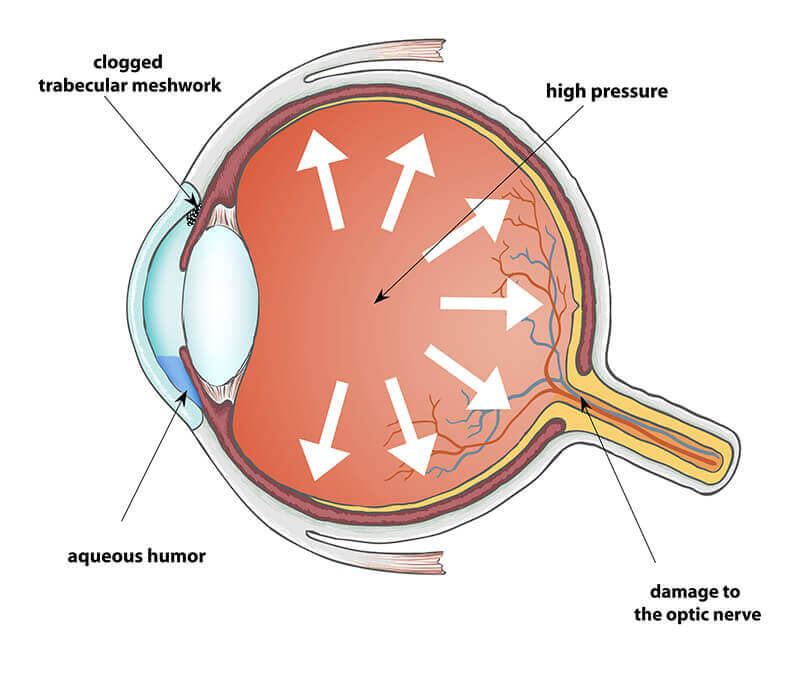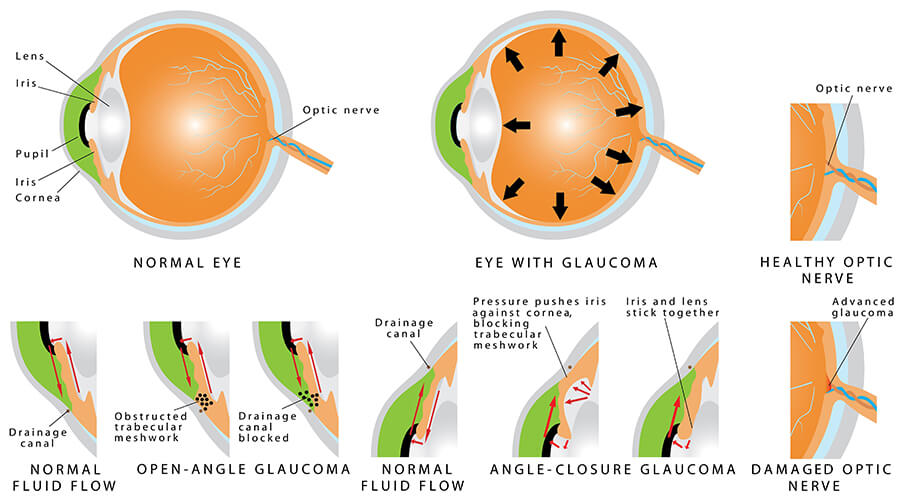Glaucoma
Glaucoma Treatment in Bellevue, Washington
Glaucoma is the second leading cause of blindness. Sometimes called the silent thief of sight, glaucoma can damage your vision so gradually you don’t notice any loss of vision until the disease is at an advanced stage. Glaucoma is an eye condition that develops when too much fluid pressure builds up inside of the eye. This increase in pressure, called intraocular pressure, can damage the optic nerve, which transmits images to the brain. If damage to the optic nerve from high eye pressure continues, glaucoma will cause loss of vision. Without treatment, glaucoma can cause total permanent blindness within a few years.
Because most people with glaucoma have no early symptoms or pain from this increased pressure, it is important to have regular routine eye exams so that glaucoma can be diagnosed and treated before long-term visual loss occurs.

What is Glaucoma?
Glaucoma is an eye disease characterized by damage to the optic nerve and loss of visual field. Often cases of glaucoma are related to elevated intraocular pressure (IOP) however it does not have to be elevated for a person to develop glaucoma. The first line of treatment for most types of glaucoma is eye drop medication that lowers the fluid pressure inside the eye. In some cases, eye surgery may be required. Left untreated, glaucoma can lead to permanent loss of sight. Glaucoma is an eye disease in which fluid pressure in the eye damages the optic nerve. This nerve damage first affects peripheral vision, but eventually can cause blindness.
Why is Glaucoma a Threat to Your Sight?
Glaucoma is one of the leading causes of blindness for patients between the ages of 18-65 years of age. Since Glaucoma does not produce any noticeable disturbance in vision until it is advanced, only half of the people who have Glaucoma actually know that they have it. More than 2.25 million Americans over the age of 40 years old have Primary Open Angle Glaucoma. National studies estimate that between 3-6 million people in the United States have higher than normal Intraocular Pressure (IOP), without obvious clinical signs of damage to the optic nerve.
Just in the United States, there are approximately 100,000 patients who are believed to be legally blind from glaucoma. Although most people are familiar with the eye disease Glaucoma, few are aware of why Glaucoma is such a significant threat to sight. Most serious eye diseases, eye conditions or eye problems usually produce some symptoms that are visible, and make patients uncomfortable or disturb their vision. Glaucoma begins without any symptoms or obvious loss of vision. In this way it is quite insidious in onset and, if not diagnosed and treated early in its course will lead to progressive, permanent, and unnoticed vision loss. It essential to diagnose and treat Glaucoma as early in its course as possible.
 One-half of glaucoma patients are not aware they have the disease. It is estimated that two million Americans may have Glaucoma.
One-half of glaucoma patients are not aware they have the disease. It is estimated that two million Americans may have Glaucoma.
Our mission is to educate the public about exploring their own personal risk of glaucoma and assuring they do not have the disease. As loss of vision from glaucoma is irreversible, this is very important when patients are without symptoms.
One of our ways of doing this is by periodic glaucoma screenings which are performed in our offices. At this screening, risk factors for glaucoma, as detailed below, are explored. In addition, the intraocular pressure is checked, and one of our glaucoma specialist doctors actually look at the optic nerve. At these screenings, the doctors can personally discuss each person’s risk factors. For those people unable to attend the screening, a risk factor analysis can be performed.
Risk Factor Analysis
- Age, over 65
- Age, over 75*
- African-American descent (or any other dark skinned race)*
- Family with glaucoma – A parent
- Family with Glaucoma- Brother or sister*
- Myopia (near-sightedness) of a significant degree
- History of previous eye injury or surgery
- Use of steroids (pills, nose spray inhalants, or eye drops) for more than a month
- Complete eye examination – More than 2 years ago
- Complete eye examination – More than 5 years ago*
* If you have more than two of these risk factors, or any of the risk factors with an asterisk, consider yourself at moderate or high risk for glaucoma.
We suggest everyone have a periodic eye examination, but those at risk should seek an examination soon (within the next few months).
Types of Glaucoma
Glaucoma is a group of diseases that can damage the eye’s optic nerve and result in vision loss and blindness. Early treatment is important to prevent serious vision loss. There are 5 types of glaucoma:





